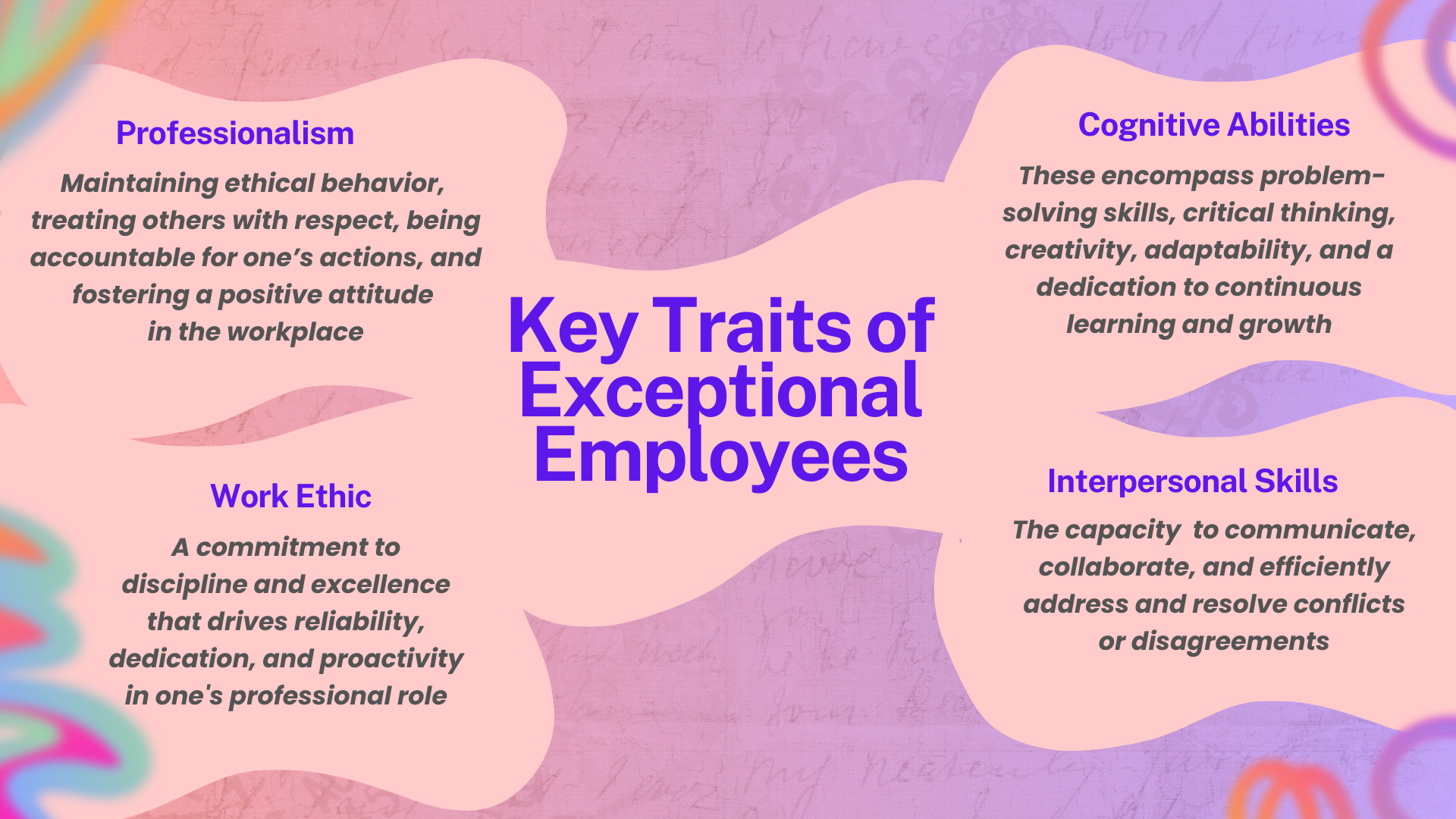The 10 Must-Have Qualities of Every Good Employee
Discover the top 10 must-have qualities of every great employee that can make a huge difference in the success of your organization.

As a manager or business owner, you know that having the right employees can make all the difference in your organization's success.
But what makes an employee truly great?
What qualities are essential for them to possess to excel in their role and contribute to the company's growth and prosperity?
The business world keeps changing, and strong employees are the key to winning.
By understanding these key traits, you'll be better equipped to identify and cultivate top talent within your organization, leading to improved productivity, employee retention, and overall success.
10 Traits of Successful Employees
Adaptability

Adaptability is not imitation. It means power of resistance and assimilation. – Mahatma Gandhi
Studies show that adaptability is the key driver of employees' performance.
In the workplace, adaptability is linked to emotional intelligence, allowing employees to navigate change smoothly, a trait highly valued in dynamic work environments.
How to Evaluate Employee Adaptability
Observing their behavior in different situations
- Watch how they handle unexpected changes, new tasks, or challenges. Do they adjust quickly or struggle with the transition?
Assessing their ability to learn new things
- Provide opportunities for employees to learn new skills or technologies. Observe how quickly they pick up new information and apply it effectively.
Evaluating their flexibility in work schedules and assignments
- Offer flexible work arrangements or change their job duties occasionally. See how well they adapt to these changes and if they can manage their time effectively.
Conducting performance evaluations
- Regularly review an employee's performance and provide feedback on areas where they could improve their adaptability. Discuss how they handle stressful situations, their willingness to take on new responsibilities, and their openness to learning from mistakes.
Monitoring their attitude toward change
- Pay attention to how employees react to organizational changes, such as restructuring, policy updates, or new initiatives. Do they embrace change or resist it?
Assessing their emotional intelligence
- Emotional intelligence is closely linked to adaptability. Look for signs of self-awareness, empathy, and social skills in employee interactions and communications.
Reviewing their resilience under pressure
- Observe how employees cope with high-stress situations, tight deadlines, or conflicting priorities. Do they maintain their composure and find ways to manage stress effectively?
Evaluating their ability to work in diverse teams
- Assign employees to projects with people from different backgrounds, cultures, or departments. Note how well they collaborate, communicate, and adapt to working with others who may have different perspectives and approaches.
Communication Skills

The art of communication is the language of leadership. – James Humes
In the workplace, good communicators convey their ideas clearly, foster teamwork, and resolve conflicts in collaborative settings effectively.
How to Evaluate Employee Communication Skills
Observe Interactions
- Listen to how they communicate in different situations and with different audiences. See how they adapt communication styles to various channels (video chat, email, etc.).
Presentations & Meetings
- Watch presentations and meetings to assess clarity, conciseness, and ability to handle questions.
Review Written Communication
- Monitor emails and reports for professionalism, clarity, and proper grammar.
Response to Communication Training
Provide opportunities to learn new skills like active listening or public speaking and evaluate the results.
Performance Reviews
- Offer specific feedback on communication strengths and areas for improvement.
Monitor Feedback Receptiveness
- See how open they are to feedback and their willingness to learn.
Work Ethic

The difference between ordinary and extraordinary is that little extra." - Jimmy Johnson (NFL Coach)
In the workplace, having a solid work ethic is vital for success as it promotes productivity, quality, a positive environment, and trust/respect through dedication, good time management, emphasis on excellence, reliability, professionalism, and consistent effort.
How to Evaluate Employee Work Ethics
Observe Task Completion
- Track how consistently and efficiently they complete assigned tasks. Do they meet deadlines and consistently deliver high-quality work?
Initiative and Proactivity
- See if they take initiative on tasks, identify problems, propose solutions, or go the extra mile without being prompted.

Time Management
- Apply time tracking software to unobtrusively observe their ability to prioritize tasks, manage their time effectively, and avoid procrastination.
Meeting Participation
- Evaluate their engagement in meetings. Do they arrive prepared, actively participate, and contribute valuable insights?
Teamwork and Collaboration
- See how effectively they collaborate with colleagues, share credit for team successes, and offer support to others.
Attitude and Work Style
- Observe their overall attitude towards work. Are they enthusiastic, reliable, and committed to achieving goals?
Workload Management
Assign them challenging tasks and see how they handle them. Can they maintain focus and productivity?

Feedback Receptiveness
- Pay attention to how they react to feedback or constructive criticism. Do they take it in stride and use it to improve?
Professionalism and Dependability
- Observe their professionalism, punctuality, and commitment to following company policies and procedures.
Problem-Solving Skills

By a witty observation of the Reddit commentator, employees with problem-solving skills demonstrate high precision in targeting goals:
“Guided Missile” employees who I can give an objective and then they just get it done with creativity and minimal direction. They tell me what I need, I provide it, and they take it from there.
In the workplace, problem-solving skills enable employees to address challenges creatively and efficiently, reducing downtime and fostering innovation.
How to Evaluate Employee Problem-Solving Skills
Empowerment and Ownership
- Give employees the autonomy to tackle problems within their roles. Provide resources to support their efforts. Evaluate if you can trust their judgment.
Culture of Learning and Experimentation
- Observe if the employee is ready to explore new ideas and take positive steps in problem-solving.

Training and Development
- Invite employees to workshops on specific frameworks, like design thinking, root cause analysis, or critical thinking and analytical skills training.
Mentorship and Collaboration
- Encourage teamwork and collaboration on problems and evaluate how well employees see their strengths and perspectives.
Bonus Tip: Recognition and Rewards
- Never neglect public recognition and bonuses for employees who take on more challenging projects. Highlighting successful problem-solving efforts motivates others and reinforces the desired behavior.
Teamwork

Alone we can do so little; together we can do so much. – Helen Keller
In the workplace, team-oriented employees enhance group cohesion and drive collective success, as evidenced by improved project outcomes and employee morale.
How to Evaluate Employee Teamwork
Shared workload and responsibilities
- Team members actively share tasks, delegate effectively, and support one another to ensure all aspects of the project are covered.
Open communication and information sharing
- Team members actively listen to each other's perspectives and seek input from others before making decisions.
Effective use of collaborative tools
- The team utilizes tools like project management platforms, communication channels, and shared documents to stay on the same page and work together efficiently.
Synergy and leveraging strengths
- Team members recognize each other's advantages and weaknesses. They leverage individual expertise to find creative solutions and make well-rounded decisions.
Continuous Learning

If we become increasingly humble about how little we know, we may be more eager to search. – Sir Ian Templeton
In the workplace, commitment to lifelong learning is associated with greater adaptability to change, leading to career longevity and advancement.
How to Evaluate Employee Continuous Learning
Learning and Development Mindset
- These employees are eager to learn new skills and improve their existing ones. They actively seek training opportunities to broaden their knowledge base.
Focus on Innovation and Experimentation
- They are not afraid to try new things and experiment with different approaches. They are open to innovative ideas and seek ways to improve existing processes or products.
Creativity

Creativity is thinking up new things. Innovation is doing new things. – Theodore Levitt
In the workplace, creative employees contribute to a culture of innovation, helping businesses stay competitive and relevant in rapidly changing industries.
How to Evaluate Employee Creativity
Frequently Proposing New Ideas and Approaches
- Are they constantly brainstorming and suggesting improvements?
Inspiring and Motivating Others with Their Creative Vision
- Can they clearly communicate their ideas and get buy-in from others?
Thinking of Innovative Ways to Improve Processes or Products
- Do they challenge the status quo and suggest better ways of doing things?
Bringing Fresh Perspectives to Discussions and Projects
- Do they offer unique viewpoints that spark new ideas?
Emotional Intelligence (EQ)

Emotional intelligence does not mean merely 'being nice'. At strategic moments it may demand not 'being nice', but rather, for example, bluntly confronting someone with an uncomfortable but consequential truth they’ve been avoiding. – Daniel Goleman
In the workplace, EQ enables employees to manage their emotions and understand those of others, leading to better teamwork, leadership, and customer interactions.
How to Evaluate Employee EQ
Recognizing Emotions
- They understand their own emotions and how they impact their behavior.
Self-Regulation
- They can manage their emotions effectively, especially under pressure. They don't let anger, frustration, or excitement cloud their judgment.
Communication
- They communicate clearly and effectively, adapting their style to the audience. They actively listen and consider different perspectives.
Conflict Resolution
- They can approach disagreements constructively, focusing on finding solutions rather than assigning blame.

Reliability

Reliability is the precondition for trust. – Wolfgang Schauble
In the workplace, reliability means meeting deadlines and commitments, which builds trust and stability within teams.
How to Evaluate Employee Reliability
Consistency and Dependability
- A reliable employee consistently shows up on time, meets deadlines, and delivers high-quality work. They can be counted on to complete their tasks and assignments without constant supervision or reminders.
Accountability and Follow-Through
- Reliable employees take ownership of their work. They see projects through to completion, address any issues, and are accountable for their actions and decisions.
Leadership Potential

Leadership is the capacity to translate vision into reality. – Warren Bennis
In the workplace, leadership skills, including the ability to inspire and guide others, are not just for managers but elevate the team's performance and morale.

Emphasizing these traits can guide professional development efforts and hiring practices to foster a thriving, productive work environment.
How to Evaluate Employee Leadership Skills
Initiative and Proactivity
- Do they identify problems and take steps to address them before they escalate?
Do they anticipate potential challenges and propose solutions proactively?
When faced with obstacles, do they take ownership and find creative ways to overcome them?
Decision-Making and Strategic Thinking
- Do they approach challenges with a thoughtful and analytical approach?
- Can they weigh options, assess risks, and make sound decisions?
- Do they demonstrate the ability to think strategically and consider long-term implications?
Wrap Up
In summary, let's remember that the heart of any company beats strongest through its people.
Qualities such as reliability, honesty, creativity, the ability to communicate effectively, emotional intelligence, an eagerness to learn, and a spirit of teamwork do more than just pave the path for personal achievement.

They are the lifeblood of a thriving corporate culture, enhancing productivity, delighting customers, and sparking innovation.
These attributes enable a company to gracefully adapt to market trends, ensuring its survival and flourishing success.
At the end of the day, these human qualities make our workplaces more than just places of work but communities where success is a shared journey.
Use TMetric to help you identify these qualities within your organization and cultivate a high-performing team poised for success.


